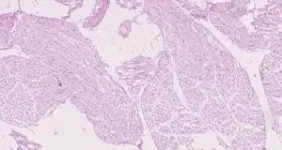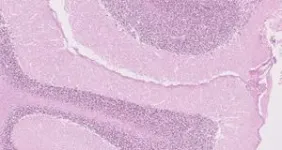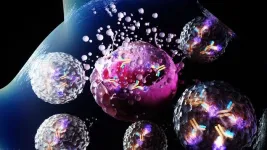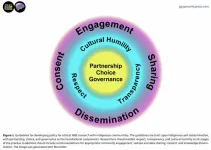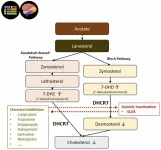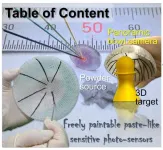(Press-News.org) Despite what was previously thought, new research has shown that genetic changes alone cannot explain why and where tumours grow in those with genetic condition neurofibromatosis type 1 (NF-1). Understanding more about the factors involved could, in the future, facilitate early cancer detection in NF-1 patients and even point towards new treatments.
Researchers from the Wellcome Sanger Institute, UCL Great Ormond Street Institute of Child Health, Great Ormond Street Hospital, Cambridge University Hospitals NHS Foundation Trust, and their collaborators, focused on NF-1, a genetic condition that causes specific types of tumours, and investigated how and why these developed.
The study, published today (25 February) in Nature Genetics, reports that the genetic changes thought to cause tumours can be found in normal tissues throughout the body, suggesting that other factors are also necessary for tumour development.
They also uncovered a pattern of changes in the affected gene, NF1, that may explain why the nervous system in particular is a common site for these tumours to develop.
Understanding what other factors are involved in developing these tumours could help inform monitoring programmes for patients with NF-1, who require regular screening to detect tumours early on and could potentially require multiple surgeries and chemotherapy.
In the future, refining our knowledge of why tumours grow in some places and not others may help us identify the patients most likely to need early medical intervention.
This model of tumour development is not unique to NF-1, raising the possibility that similar events occur in related genetic conditions, meaning many more could benefit from tailored management.
NF-1 is a genetic condition that causes brown skin patches, similar to birthmarks, and tumours1. While the tumours are often benign, they can become cancerous over time and may cause a range of symptoms depending on where they are1. For example, NF-1 can cause soft tissue and brain tumours that may restrict movement and vision.
The symptoms and impact of NF-1 can vary greatly from person to person. It is one of the most common inherited genetic conditions, impacting around one in 2500 people, with approximately 25,000 people in the UK living with this condition2. Those with NF-1 have a genetic change that means one copy of the gene encoding the neurofibromin protein, NF1, does not work. It was previously thought that tumours and brown skin patches occurred when the second copy of the gene was lost.
In a new study, researchers from the Sanger Institute, UCL Great Ormond Street Institute of Child Health, Great Ormond Street Hospital, Cambridge University Hospitals NHS Foundation Trust, and their collaborators, studied nearly 500 tissue samples from a child with NF-1 and compared them to tissues from children without the condition.
They found that changes causing a loss of NF1 gene function were not limited to tumours and skin changes but instead can be found throughout other tissues of the child with NF-1 as well. This suggests, whilst advantageous to the affected cells, the mutation is insufficient to cause tumour formation.
For this research, the team applied a new sequencing technology that allowed them to look at genetic changes at a higher resolution than was previously possible and studied additional tissue samples from nine adults with NF-1, showing similar findings.
The team found a pattern of mutations across all patients that showed these were particularly common in tissues of the nervous system. This is a common place for tumours to form in those with NF-1, which can help explain why these tissues are specifically impacted.
Dr Thomas Oliver, co-first author from the Wellcome Sanger Institute and Cambridge University Hospitals NHS Foundation Trust, said: “We were astonished to see such extensive genetic changes in the normal tissues of patients with NF-1, seemingly without consequence. This is contrary to our understanding of tumour development in the condition and other related conditions. Additional factors must clearly play a role, perhaps including the cell type and anatomical location affected. Whilst further investigation is needed, I hope this work represents the first step towards developing more personalised care for these patients, such as better identifying who is at greater risk of developing tumours, and adjusting screening to intervene early on and minimise complications.”
Professor Thomas Jacques, co-senior author from UCL Great Ormond Street Institute of Child Health and Great Ormond Street Hospital, said: “NF-1 can have many different impacts on a person’s life. In order to better treat and support those with NF-1, we have to understand more about what is going on at a biological and genetic level, especially in the parts of the body that are most affected, such as the brain and nervous system. Our study showed that these areas of the body have a different pattern of DNA changes, suggesting that if we look further, there could be a potential target for new therapies to help treat or stop tumour development.”
Professor Sam Behjati, co-senior author from the Wellcome Sanger Institute and Cambridge University Hospitals NHS Foundation Trust, said: “Loss of the second NF1 gene had always been thought to cause tumours in individuals with NF-1. Our findings fundamentally question this decade-old paradigm and force us to rethink how tumours arise, to pave the way for better screening, prevention, and treatment of cancers.”
ENDS
Contact details:
Rachael Smith
Press Office
Wellcome Sanger Institute
Cambridge, CB10 1SA
07827979492
Email: press.office@sanger.ac.uk
Notes to Editors:
NHS. Neurofibromatosis type 1, overview and symptoms pages. Available at: https://www.nhs.uk/conditions/neurofibromatosis-type-1/ [Accessed February 2025]
Nerve Tumours UK. What is neurofibromatosis type 1? Available at: https://nervetumours.org.uk/what-are-nerve-tumours/what-is-nf1
Publication:
T. R. W. Oliver, A. R. J . Lawson, H. Lee-Six, et al. (2025) Cancer-independent, second somatic NF1 mutation of normal tissues in neurofibromatosis type 1. Nature Genetics. DOI: 10.1038/s41588-025-02097-2
Funding:
This research includes funding from Wellcome, the Brain Tumour Charity, Great Ormond Street Hospital Children’s Charity, and others. A full acknowledgment list can be found in the publication.
Selected websites:
About UCL – London’s Global University
UCL is a diverse global community of world-class academics, students, industry links, external partners, and alumni. Our powerful collective of individuals and institutions work together to explore new possibilities.
Since 1826, we have championed independent thought by attracting and nurturing the world's best minds. Our community of more than 50,000 students from 150 countries and over 16,000 staff pursues academic excellence, breaks boundaries and makes a positive impact on real world problems.
The Times and Sunday Times University of the Year 2024, we are consistently ranked among the top 10 universities in the world and are one of only a handful of institutions rated as having the strongest academic reputation and the broadest research impact.
We have a progressive and integrated approach to our teaching and research – championing innovation, creativity and cross-disciplinary working. We teach our students how to think, not what to think, and see them as partners, collaborators and contributors.
For almost 200 years, we are proud to have opened higher education to students from a wide range of backgrounds and to change the way we create and share knowledge.
We were the first in England to welcome women to university education and that courageous attitude and disruptive spirit is still alive today. We are UCL.
www.ucl.ac.uk | Read news at www.ucl.ac.uk/news/ | Listen to UCL podcasts on SoundCloud | View images on Flickr | Find out what’s on at UCL Minds
About Cambridge University Hospitals
Cambridge University Hospitals NHS Foundation Trust (CUH) is one of the largest and best known trusts in the country, delivering high-quality patient care through Addenbrooke’s and the Rosie Hospitals. CUH is a leading national centre for specialist treatment for rare or complex conditions and a university teaching hospital with a worldwide reputation.
CUH is a key partner in Cambridge University Health Partners (CUHP), one of only eight academic health science centres in the UK, and is at the heart of the development of the Cambridge Biomedical Campus (CBC), which brings together on one site a range of organisations involved in world-class biomedical research, patient care and education. The Campus hosts the National Institute for Health and Care Research (NIHR) Cambridge Biomedical Research Centre.
The Wellcome Sanger Institute
The Wellcome Sanger Institute is a world leader in genomics research. We apply and explore genomic technologies at scale to advance understanding of biology and improve health. Making discoveries not easily made elsewhere, our research delivers insights across health, disease, evolution and pathogen biology. We are open and collaborative; our data, results, tools, technologies and training are freely shared across the globe to advance science.
Funded by Wellcome, we have the freedom to think long-term and push the boundaries of genomics. We take on the challenges of applying our research to the real world, where we aim to bring benefit to people and society.
Find out more at www.sanger.ac.uk or follow us on Twitter, Instagram, Facebook, LinkedIn and on our Blog.
About Wellcome
Wellcome supports science to solve the urgent health challenges facing everyone. We support discovery research into life, health and wellbeing, and we’re taking on three worldwide health challenges: mental health, infectious
END
Research challenges our understanding of cancer predisposition
2025-02-25
ELSE PRESS RELEASES FROM THIS DATE:
What makes cancer cells weak
2025-02-25
One particular challenge in the treatment of cancer is therapy resistance. An international research team has now discovered a mechanism that opens up new treatment strategies for tumours in which conventional chemotherapeutic agents have reached their limits. "Cytotoxic agents from nature lead to an increased incorporation of polyunsaturated fatty acids into the membrane of cancer cells. This makes them more susceptible to ferroptosis, a type of cell death, at a very early stage," reports Andreas Koeberle, a pharmacist at the University of Graz and lead author of the study, which has just been published in the scientific journal Nature ...
Robots learn how to move by watching themselves
2025-02-25
New York, NY—Feb. 25, 2025— By watching their own motions with a camera, robots can teach themselves about the structure of their own bodies and how they move, a new study from researchers at Columbia Engineering now reveals. Equipped with this knowledge, the robots could not only plan their own actions, but also overcome damage to their bodies.
"Like humans learning to dance by watching their mirror reflection, robots now use raw video to build kinematic self-awareness," says study lead author Yuhang Hu, a doctoral student at the Creative Machines Lab at Columbia University, directed by Hod Lipson, James and Sally Scapa Professor of Innovation and chair of the Department ...
MD Anderson researchers develop novel antibody-toxin conjugate
2025-02-25
HOUSTON ― Researchers at The University of Texas MD Anderson Cancer Center have developed a novel antibody-toxin conjugate (ATC) designed to stimulate immune-mediated eradication of tumors. According to preclinical results published today in Nature Cancer, the new approach combined the benefits of more well-known antibody-drug conjugates (ADCs) with those of immunotherapies.
ADCs have emerged as a breakthrough in recent years due to their modular design, which enables precise delivery of therapies to tumors by targeting specific proteins expressed on cancer cells. These conjugates ...
One in ten older South Asian immigrants in Canada have hypothyroidism
2025-02-25
Toronto, ON – A new study published this week in Archives of Gerontology and Geriatrics Plus found that 10% of South Asian immigrants aged 45 and older in Canada had hypothyroidism. After adjustment for a wide range of sociodemographic characteristics and health behaviors, those who had immigrated from South Asia had 77% higher odds of hypothyroidism than those born in Canada.
“To the best of our knowledge, this is the first study to identify a significantly higher odds of hypothyroidism among immigrants of South Asian descent,” says senior author Esme Fuller-Thomson, a Professor at Factor-Inwentash Faculty of Social Work (FIFSW) and Director ...
Substantial portion of cancer patients in early trials access drugs that are later approved
2025-02-25
A new paper in the Journal of the National Cancer Institute, published by Oxford University Press, finds that almost 20% of patients in middle-stage cancer drug trials receive treatment that eventually prove effective enough to get FDA approval. This may have important implications for drug development and clinical trial recruitment.
The development of new medications typically has three stages. In phase 1 trials, researchers assess drugs for safety and dosing (“What is the best tolerated dose for the patient?”). Phase 2 clinical trials determine whether a new drug shows signs of efficacy (“How much does the ...
New study calls for ethical framework to protect Indigenous genetic privacy in wastewater monitoring
2025-02-25
GUELPH, Ontario, Canada, 25 February 2025 – In a comprehensive peer-reviewed Perspective (review) article, researchers from the University of Guelph have outlined an urgent call for new ethical frameworks to protect Indigenous communities' genetic privacy in the growing field of wastewater surveillance. The study, published today in Genomic Psychiatry (Genomic Press New York), examines how the analysis of community wastewater – while valuable for public health monitoring – raises significant privacy concerns for Indigenous populations.
"Wastewater-based ...
Common medications may affect brain development through unexpected cholesterol disruption
2025-02-25
OMAHA, Nebraska, USA, 25 February 2025 - In a peer-reviewed Perspective (review) article, researchers at the University of Nebraska Medical Center have uncovered concerning evidence that commonly prescribed medications may interfere with crucial brain development processes by disrupting sterol biosynthesis. Their findings, published today in Brain Medicine (Genomic Press, New York), suggest that this previously overlooked mechanism could have significant implications for medication safety during pregnancy and early development.
"What we've discovered is that many prescription medications, while designed for entirely different purposes, can inadvertently interfere with the brain's ...
Laser-powered device tested on Earth could help us detect microbial fossils on Mars
2025-02-25
The first life on Earth formed four billion years ago, as microbes living in pools and seas: what if the same thing happened on Mars? If it did, how would we prove it? Scientists hoping to identify fossil evidence of ancient Martian microbial life have now found a way to test their hypothesis, proving they can detect the fossils of microbes in gypsum samples that are a close analogy to sulfate rocks on Mars.
“Our findings provide a methodological framework for detecting biosignatures in Martian sulfate minerals, potentially guiding ...
Non-destructive image sensor goes beyond bulkiness
2025-02-25
While photo-thermoelectric (PTE) sensors are potentially suitable for testing applications, such as non-destructive material-identification in ultrabroad millimeter-wave (MMW)–infrared (IR) bands, their device designs have primarily employed a single material as the channel. In general, PTE sensors combine photo-induced heating with associated thermoelectric (TE) conversion, and the employment of a single material channel regulates the utilization of devices by missing the opportunity for fully utilizing their fundamental parameters. ...
1st Japanese version of US psychological scale for esophageal symptoms
2025-02-25
Psychological factors have a greater impact on the severity of symptoms in esophageal diseases than objective evaluations, such as acid reflux and esophageal motility function. Although there are questionnaires that assess general psychological states in Japan, there were none that were specific to esophageal symptoms. In the United States, meanwhile, the Esophageal Hypervigilance and Anxiety Scale (EHAS) questionnaire that evaluates symptom-specific hypervigilance and anxiety for esophageal symptoms was developed in 2018.
In an effort to expand the use of EHAS, Dr. Akinari Sawada’s research group at Osaka Metropolitan ...

